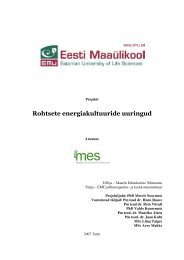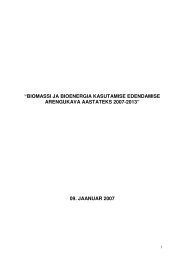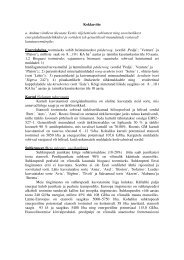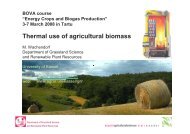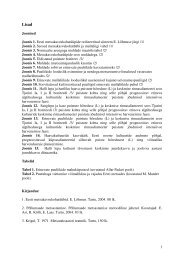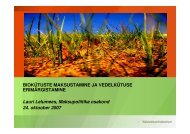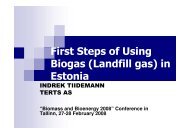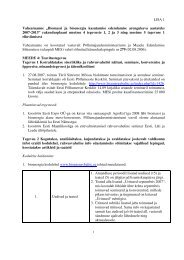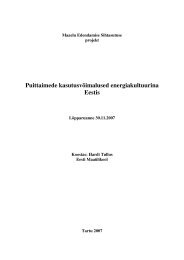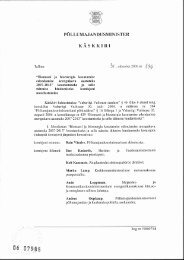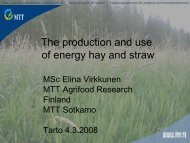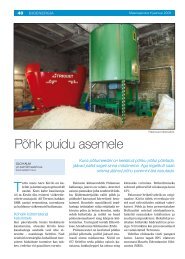Põllumajandusministeeriumi ja Maaelu ... - bioenergybaltic
Põllumajandusministeeriumi ja Maaelu ... - bioenergybaltic
Põllumajandusministeeriumi ja Maaelu ... - bioenergybaltic
You also want an ePaper? Increase the reach of your titles
YUMPU automatically turns print PDFs into web optimized ePapers that Google loves.
produced by farmers or industry and distributed by logistic services or by fuel stations.<br />
Finally, the last actors in the life cycle of biofuels are the consumers of biofuels.<br />
Social and environmental impacts of using biofuels instead of fossil fuels can only be assessed<br />
if the whole life cycle is considered. In order to facilitate comparison impacts between fossil<br />
and renewable fuels, the following life cycle of fossil fuels has to be taken into account:<br />
1) exploration;<br />
2) transport;<br />
3) refining of crude oil;<br />
4) storage and<br />
5) distribution (fuelling of the vehicle).<br />
Ecological impact and dangers related to biomass based energy products<br />
Estimations of the savings in greenhouse gas emissions vary widely. CO 2 savings found in<br />
studies and reports lie in the range of 25 to 80 percent for RME. This means that 25 to 80<br />
percent less CO 2 is emitted using RME instead of fossil diesel for the same purpose. Besides<br />
CO 2 , another greenhouse gas, N 2 O, is emitted in the biofuel lifecycle, due to the application of<br />
nitrogen fertilizers. N 2 O has a high potential factor for global warming; about 310 times<br />
higher than CO 2 . N 2 O emissions are highest for biofuels produced from rapeseed, because of<br />
the relatively high use of nitrogen fertiliser in rapeseed production. For RME, N 2 O emissions<br />
result in a loss of about 10 to 15 percent of the equivalent CO 2 savings.<br />
In addition to the low level of cost-efficiency and the limited potential for reductions in<br />
greenhouse gas emissions, there are also some environmental risks associated with the<br />
production of biofuels. The European Commission promotes the cultivation of biofuel crops<br />
on land which is currently set aside. In fact, this just means an extension of the area used for<br />
intensive farming, since the biofuel crops are among the most commonly used of food crops.<br />
On set-aside land, which is not used for food production, the cultivation of energy crops will<br />
produce a greater environmental impact on soil and groundwater than leaving it fallow. When<br />
land is set aside, it recovers at least part of its soil life (invertebrates), but this will be reversed<br />
if the land is used once again for intensive production of agricultural crops. Nutrients such as<br />
nitrogen and phosphorous, and pesticides used in intensive agriculture, can end up in soil,<br />
groundwater or surface waters. Here they can cause eutrophication or toxification of<br />
ecosystems, which have consequences for ecosystem health and biodiversity. For instance,<br />
pesticides kill invertebrates in the soil, thereby taking away the source of food for birds such<br />
as the grey partridge, corn bunting and skylark.<br />
Comparison of Biodiesel and biolubricants with fossil analogues<br />
For the production of fossil diesel with energy content of 1 MJ they spent 1.2007 MJ of<br />
primary energy. Hence the energy efficiency of the respective life cycle is 83.28%. It takes<br />
1.2314 MJ of primary energy to produce a quantity of biodiesel with the energy content of one<br />
MJ, which makes the energy efficiency of the respective life cycle 80.55%. There are no big<br />
differences in the energy efficiency of biodiesel compared to fossil diesel (83.28% and<br />
80.55% respectively).<br />
Comparisons of the carbon dioxide emissions of biodiesel and ordinary diesel indicate that<br />
emissions of carbon dioxide from burning biodiesel in the engine are 4.7% bigger than from<br />
burning fossil diesel. At the same time, replacement of fossil diesel with biodiesel reduces<br />
most of the emissions into air during the life cycle. The biggest advantage of biodiesel is its<br />
emission of carbon monoxide (CO). Compared to fossil diesel the respective emission in the<br />
case of pure biodiesel (B100) is 34.5% smaller. And biodiesel B100 has also 32.41% smaller<br />
emission of volatile particles (TPM). However, hydro carbonates (THC) were emitted during<br />
the life cycle of biodiesel B100 35% more than in the lifecycle of fossil diesel. The emissions<br />
110




